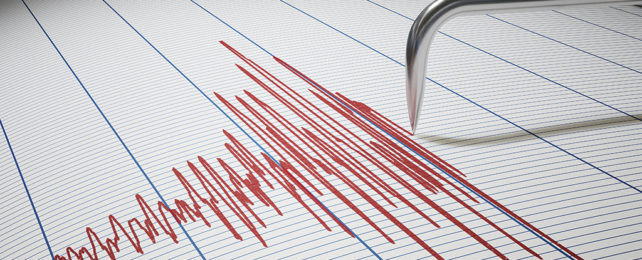When the next big earthquake strikes somewhere around the world, it will arrive without warning, destroying infrastructure and putting lives at risk.
Yet for days leading up to the event, titanic geological forces will already be at work, warping the crust in subtle ways that could, in theory, predict the coming catastrophe.
One possible sign could involve flickers in the magnetic field that ebbs and flows around our planet. For decades, researchers have debated the merits of hunting for magnetic signatures to imminent tremors, for want of convincing evidence.
A new case-controlled study by QuakeFinder, a humanitarian research project within systems engineering services company Stellar Solutions, in collaboration with the Google Accelerated Science team, concludes there just might be a good reason to continue the search.
Applying machine learning to ground-based measurements of local magnetic changes in the lead-up to a number of significant earthquakes across California between 2005 and 2019, the researchers found signs of a pattern that demands further study.
This isn't to say the effect they observed could necessarily be used to predict earthquakes, but it's nonetheless a fascinating lead for future study.
"We are not claiming that this signal exists before every earthquake," QuakeFinder director Dan Schneider told Joshua Rapp Learn at Eos.
Yet the findings could be enough to keep the controversial topic of electromagnetic forecasts of major tremors alive for a little longer.
Premises behind hypothetical fluctuations in the magnetic field prior to earthquakes sound reasonable enough. Some argue the massive build-up of pressure in the crust prior to a quake could, in theory, change the properties of the rock layers enough to influence their conductivity.
Other studies hint at pockets of trapped gas building up prior to release creating the necessary electrical currents to affect magnetic activity.
Spotting the resulting ultra-low frequency shifts in the magnetic field would give authorities warning that something big is going to pop, providing time to prepare in the same way communities might do for a growing hurricane.
Unfortunately, what sounds like a promising idea runs into a number of obstacles in application.
For one thing, plenty of things can create low-frequency wobbles in local patches of a magnetic field. Even increases in nearby traffic or small shifts in solar activity can introduce a buzz that might be mistaken for a geological disturbance.
Unweaving a reliable signal from this noise requires having accurate measuring equipment at fixed locations near sizable tremors. Even where that occurs, enough quakes of the right size need to be recorded for a statistical sample.
With research sites located near faults all over the state of California, Quakefinder is in a solid position to overcome these hurdles.
Magnetometers buried at the different research sites provided the researchers with a sizable amount of data on quakes greater than magnitude 4.5.
After selecting quakes for which there were measurements from two close sites, and excluding pairs of sites without suitable recordings, the researchers were left with measurements on 19 earthquakes.
This sample was then divided into two groups, one serving as the basis of a machine-learning study that attempted to sift out potential patterns from known influences, with the second group serving as a test for any possible discoveries.
The signal-to-noise ratio identified by the process and confirmed in the test run wasn't exactly strong. As the researchers admit in their published report, obvious electromagnetic anomalies prior to quakes "would have been observed, documented, and accepted much earlier" in previous investigations.
But they do suggest something intriguing is lurking in the electromagnetic shimmer like a suspicious cry in the rainstorm, one that could be present up to three days before an earthquake hits. Fine-tuning of the researchers' method using a larger sample might be able to identify what's going on.
Should future studies land upon a reliable hum of impending doom in the magnetic field of one area, it might still not be a universal tune, demanding even further testing at multiple sites around the globe.
For now, the idea of using tiny changes in the planet's magnetic field to forecast tremors remains controversial. But buoyed by results like these, further investigations might finally uncover the secret whispers of a fault at breaking point.
This research was published in the Journal of Geophysical Research: Solid Earth.
